The US-German Gravity Recovery and Climate Experiment mission (aka Grace) has taken the last two weeks to produce the most detailed map of the Earth’s gravitational field – lumps and all. Launched in March, the twin spacecraft have been orbiting the planet 16 times a day, 220 km apart from one another. A ground-based microwave ranging system measures the distance between them to see how they speed up and slow down due to changes in gravity. And this is just the low res version; scientists hope to have even more detailed maps by the end of the year.
NASA Highlights New Ways to Journey Through Space
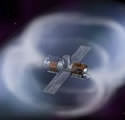
Image credit: NASA
As everybody knows, chemical rockets are too slow for space exploration. So, to speed up voyages around our Solar System, NASA is working on some new kinds of propulsion: ion engines, solar and plasma sails. Perhaps the most efficient will be hybrid systems, with different kinds of propulsion used at different points of a journey. This article gives you a breakdown of the technologies NASA’s currently working on.
“Mom, are we there yet?”
Every parent has heard that cry from the back seat of the car. It usually begins about 15 minutes after the start of any family trip. Good thing we rarely travel more than a few hundred or a few thousand miles from home.
But what if you were traveling to, say, Mars? Even at its closest approach to Earth every couple years, the red planet is always at least 35 million miles away. Six months there and six months back–at best.
“Houston, are we there yet?”
“Chemical rockets are just too slow,” laments Les Johnson, manager for in-space transportation technologies at NASA’s Marshall Space Flight Center. “They burn all their propellant at the beginning of a flight and then the spacecraft just coasts the rest of the way.” Although spacecraft can be sped up by gravity assist–a celestial crack-the-whip around planets, such as the one around Saturn that flung Voyager 1 to the edge of the solar system–round-trip travel times between planets are still measured in years to decades. And a journey to the nearest star would take centuries if not millennia.
Worse yet, chemical rockets are just too fuel-inefficient. Think of driving in a gas guzzler across a country with no gas stations. You’d have to carry boatloads of gas and not much else. In space missions, what you can carry on your trip that isn’t fuel (or tanks for fuel) is called the payload mass–e.g., people, sensors, samplers, communications gear and food. Just as gas mileage is a useful figure of merit for the fuel efficiency of a car, the “payload mass fraction”–the ratio of a mission’s payload mass to its total mass–is a useful figure of merit for the efficiency of propulsion systems.
With today’s chemical rockets, payload mass fraction is low. “Even using a minimum-energy trajectory to send a six-person crew from Earth to Mars, with chemical rockets alone the total launch mass would top 1,000 metric tons–of which some 90 percent would be fuel,” said Bret G. Drake, manager for space launch analysis and integration at Johnson Space Center. The fuel alone would weigh twice as much as the completed International Space Station.
A single Mars expedition with today’s chemical propulsion technology would require dozens of launches–most of which most would simply be launching chemical fuel. It’s as if your 1-ton compact car needed 9 tons of gasoline to drive from New York City to San Francisco because it averaged only a mile per gallon.
In other words, low-performance propulsion systems is one major reason why humans have not yet set foot on Mars.
More efficient propulsion systems increase the payload mass fraction by giving better “gas mileage” in space. Since you don’t need as much propellant, you can carry more stuff, go in a smaller vehicle, and/or get there faster and cheaper. “The key message is: we need advanced propulsion technologies to enable a low-cost mission to Mars,” Drake declared.
Thus, NASA is now developing ion drives, solar sails, and other exotic propulsion technologies that for decades have whooshed humans to other planets and stars–but only in the pages of science fiction.
From tortoise to hare
What are the science-fact options?
NASA is hard at work on two basic approaches. The first is to develop radically new rockets that have an order-of-magnitude better fuel economy than chemical propulsion. The second is to develop “propellant-free” systems that are powered by resources abundant in the vacuum of deep space.
All these technologies share one key characteristic: they start slowly, like the proverbial tortoise, but over time turn into a hare that actually wins a race to Mars–or wherever. They rely on the fact that a small continuous acceleration over months can ultimately propel a spacecraft far faster than one enormous initial kick followed by a long period of coasting.
Above: This low-thrust spaceship (an artist’s concept) is propelled by an ion engine and powered by solar electricity. Eventually the craft will pick up speed–a result of relentless acceleration–and race along at many miles per second. Image credit: John Frassanito & Associates, Inc.
Technically speaking, they’re all systems with low thrust (meaning you would barely feel the oh-so-gentle acceleration, equivalent to that of the weight of a piece of paper lying on your palm) but long operating times. After months of continuing small acceleration, you’d be clipping along at many miles per second! In contrast, chemical propulsion systems are high thrust and short operating times. You’re crushed back into the seat cushions while the engines are firing, but only briefly. After that the tank is empty.
Fuel-efficient rockets
“A rocket is anything that throws something overboard to propel itself forward,” Johnson pointed out. (Don’t believe that definition? Sit on a skateboard with a high-pressure hose pointed one way, and you will be propelled in the opposite way).
Leading candidates for the advanced rocket are variants of ion engines. In current ion engines, the propellant is a colorless, tasteless, odorless inert gas, such as xenon. The gas fills a magnet-ringed chamber through which runs an electron beam. The electrons strike the gaseous atoms, knocking away an outer electron and turning neutral atoms into positively-charged ions. Electrified grids with many holes (15,000 in today’s versions) focus the ions toward the spaceship’s exhaust. The ions shoot past the grids at speeds of up to more than 100,000 miles per hour (compare that to an Indianapolis 500 racecar at 225 mph)–accelerating out the engine into space, so producing thrust.
Where does the electricity come from to ionize the gas and charge the engine? Either from solar panels (so-called solar electric propulsion) or from fission or fusion (so-called nuclear electric propulsion). Solar electric propulsion engines would be most effective for robotic missions between the sun and Mars, and nuclear electric propulsion for robotic missions beyond Mars where sunlight is weak or for human missions where speed is of the essence.
Ion drives work. They’ve proven their mettle not only in tests on Earth, but in working spacecraft–the best-known being Deep Space 1, a small technology-testing mission powered by solar electric propulsion that flew by and took pictures of Comet Borrelly in September, 2001. Ion drives like the one that propelled Deep Space 1 are about 10 times as efficient as chemical rockets.
Propellant-free systems
The lowest-mass propulsion systems, however, may be those that carry no on-board propellant at all. In fact, they’re not even rockets. Instead, in true pioneer style, they “live off the land”–relying for energy on natural resources abundant in space, much as pioneers of yore relied for food on trapping animals and finding roots and berries on the frontier.
The two leading candidates are solar sails and plasma sails. Although the effect is similar, the operating mechanisms are very different.
A solar sail consists of an enormous area of gossamer, highly reflective material that is unfurled in deep space to capture light from the sun (or from a microwave or laser beam from Earth). For very ambitious missions, sails could range up to many square kilometers in area.
Solar sails take advantage of the fact that solar photons, although having no mass, do have momentum–several micronewtons (about the weight of a coin) per square meter at the distance of Earth. This gentle radiation pressure will slowly but surely accelerate the sail and its payload away from the sun, reaching speeds of up to 150,000 miles per hour, or more than 40 miles per second.
A common misconception is that solar sails catch the solar wind, a stream of energetic electrons and protons that boil away from the Sun’s outer atmosphere. Not so. Solar sails get their momentum from sunlight itself. It is possible, however, to tap the momentum of the solar wind using so-called “plasma sails.”
Plasma sails are modeled on Earth’s own magnetic field. Powerful on-board electromagnets would surround a spacecraft with a magnetic bubble 15 or 20 kilometers across. High-speed charged particles in the solar wind would push the magnetic bubble, just as they do Earth’s magnetic field. Earth doesn’t move when it’s pushed in this way–our planet is too massive. But a spacecraft would be gradually shoved away from the Sun. (An added bonus: just as Earth’s magnetic field shields our planet from solar explosions and radiation storms, so would a magnetic plasma sail protect the occupants of a spacecraft.)
Above: An artist’s concept of a space probe inside a magnetic bubble (or “plasma sail”). Charged particles in the solar wind hit the bubble, apply pressure, and propel the spacecraft. [more]
Of course, the original, tried-and-true propellant-free technology is gravity assist. When a spacecraft swings by a planet, it can steal some of the planet’s orbital momentum. This hardly makes a difference to a massive planet, but it can impressively boost the velocity of a spacecraft. For example, when Galileo swung by Earth in 1990, the speed of the spacecraft increased by 11,620 mph; meanwhile Earth slowed down in its orbit by an amount less than 5 billionths of an inch per year. Such gravity assists are valuable in supplementing any form of propulsion system.
Okay, now that you’ve zipping through interplanetary space, how do you slow down at your destination enough to go into a parking orbit and prepare for landing? With chemical propulsion, the usual technique is to fire retrorockets–once again, requiring large masses of onboard fuel.
A far more economical option is promised by aerocapture–braking the spacecraft by friction with the destination planet’s own atmosphere. The trick, of course, is not to let a high-speed interplanetary spacecraft burn up. But NASA scientists feel that, with an appropriately designed heat shield, it would be possible for many missions to be captured into orbit around a destination planet with just one pass through its upper atmosphere.
Onward!
“No single propulsion technology will do everything for everybody,” Johnson cautioned. Indeed, solar sails and plasma sails would likely be useful primarily for propelling cargo rather than humans from Earth to Mars, because “it takes too long for those technologies to get up to escape velocity,” Drake added.
Nonetheless, a hybrid of several technologies could prove to be very economical indeed in getting a manned mission to Mars. In fact, a combination of chemical propulsion, ion propulsion, and aerocapture could reduce the launch mass of a 6-person Mars mission to below 450 metric tons (requiring only six launches)–less than half that attainable with chemical propulsion alone.
Such a hybrid mission might go like this: Chemical rockets, as usual, would get the spacecraft off the ground. Once in low-Earth orbit, ion drive modules would ignite, or ground controllers might deploy a solar or plasma sail. For 6 to 12 months, the spaceship–temporarily unmanned to avoid exposing the crew to large doses of radiation in Earth’s Van Allen radiation belts–would spiral away, gradually accelerating up to a final high Earth-departure orbit. The crew would then be ferried out to the Mars vehicle in a high-speed taxi; a small chemical stage would then kick the vehicle up to escape velocity, and it would head onward to Mars.
As Earth and Mars revolve in their respective orbits, the relative geometry between the two planets is constantly changing. Although launch opportunities to Mars occur every 26 months, the optimal alignments for the cheapest, fastest possible trips happen every 15 years–the next one coming in 2018.
Perhaps by then we’ll have a different answer to the question, “Houston, are we there yet?”
Original Source: NASA Science Story
Bass Ejected from Space Mission
Russian space officials sent a letter to their partners today, announcing that astronaut candidate, and ‘N Sync member, Lance Bass was kicked off October’s Soyuz mission to the International Space Station. Apparently the sponsors for the trip were unable to raise the $20 million required to finance the mission, so the Russians finally pulled the plug. Of course, the trip promoters are optimistic; if they can find a sponsor for the trip, and convince Russian officials that Bass can still sneak on board then maybe, just maybe, the 23 year old singer will get his shot into space. (MSNBC story)
Don’t Worry, Everything’s Fine
I apologize for the extensive delays in the last month. I’ve had a series of problems conspire together to keep me from being able to maintain Universe Today: a busted computer, a move to a new house, more work, no Internet, and the attentions of a 10 month old daughter. I think we’re through the worst of it. Thanks for all your support. 🙂
Fraser Cain
Publisher
Comets May Break up More Often than Thought
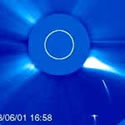
Image credit: SOHO
Researchers with NASA’s Jet Propulsion Laboratory believe that comets may break up several times before being consumed by the Sun, often taking several orbits to fully come apart. The team analyzed photographs of the region around the Sun and found that comets passed by in clusters or in parallel paths. The pieces are so small that should have disintegrated had they passed the Sun on an earlier trip. This means that the parent comet must have broken up after it passed the Sun.
Some comets may break apart over and over again in the farthest reaches of the solar system, challenging a theory that comets break up only occasionally and not too far from the Sun, says a researcher from NASA’s Jet Propulsion Laboratory, Pasadena, Calif.
A system of comets called “sungrazers,” named for their orbit that closely brushes the Sun, reveals important clues about how these bodies break up. Most sungrazing comets are tiny — the smallest could be less than 10 meters (30 feet) across — and move in a highway-like formation of comets that pass near the Sun and disintegrate.
Dr. Zdenek Sekanina, senior research scientist at JPL, reports in the September 10 issue of the Astrophysical Journal that many sungrazer comets arrive at the Sun in clusters and on parallel paths. He emphasizes that such tiny fragments would have disintegrated if they had come so close to the Sun on an earlier trip. Therefore, the parents of these tiny sungrazers must have broken up after their previous encounter with the Sun and continued to break up far from the Sun on their journey through the solar system.
Sekanina’s sungrazer studies challenge an earlier theory that the only place these comets break up is very close to the Sun, as the strong pull of its gravity cracked their loosely piled chunks of dust and ice. The gradual, continuing fragmentation gives birth to all the sungrazers, the most outstanding examples of splitting comets.
“Astronomers never before realized that there could be a fairly orderly pattern in breaking up, so that one comet cascades into large families of smaller comets, and that this process could be an important part of a comet’s natural life cycle,” Sekanina said.
Sungrazers are not the only comets that can break up far from the Sun. Sekanina points to new observations of comet 57P/du Toit-Neujmin-Delporte, whose fragmentation has led to the formation of a similar, though less prominent, highway of tiny comets. All fragments separated from the comet beyond the orbit of Mars.
Images taken by the European Space Agency’s and NASA’s Solar and Heliospheric Observatory have shown the many tiny sungrazing comets. A movie showing two of these comets can be found at: http://sohowww.nascom.nasa.gov/gallery/LASCO/c2_comets.mpg.
Nearly seven years’ worth of images from the solar observatory revealed more than 400 sungrazers in the Sun’s immediate neighborhood. Sekanina estimates that currently there may be as many as 200,000 sungrazer comets the size of the ones the observatory detected.
The Solar and Heliospheric Observatory is a project of international cooperation between the European Space Agency and NASA. The spacecraft is part of the International Solar-Terrestrial Physics program, a global effort to study the interaction of Sun and Earth. The instrument that observed the comets was developed at the U.S. Naval Research Laboratory, Washington, D.C., with collaborators in the United Kingdom, France and Germany. JPL, a division of the California Institute of Technology in Pasadena, manages the Planetary Atmospheres program for NASA’s Office of Space Science, Washington, D.C.
Original Source: NASA News Release
Supernova Remnant Seen Through Chandra
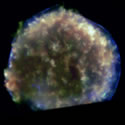
Image credit: Chandra
The Chandra X-Ray Observatory recently captured a fascinating image of the Tycho supernova remnant. The 20 million degree expanding shockwave of gas and dust is visible at the outside edges of the object; the stellar debris inside is 10-million degrees cooler, and only visible in X-rays. The original supernova explosion was seen by Dutch astronomer Tycho Brahe in the Year 1572.
This Chandra image reveals fascinating details of the turbulent debris created by a supernova explosion that was observed by the Danish astronomer Tycho Brahe in the year 1572. The colors show different X-ray energies, with red, green, and blue representing low, medium and high energies, respectively. The image is cut off at the bottom because the southernmost region of the remnant fell outside the field of view of the detector.
A shock wave produced by the expanding debris is outlined by the strikingly sharp blue circular arcs of twenty million degree Celsius gas seen on the outer rim. The stellar debris, which has a temperature of about ten million degrees and is visible only in X-rays, shows up as mottled yellow, green and red fingers of gas.
Tycho’s supernova remnant presents several interesting contrasts with the Cassiopeia A (Cas A) supernova remnant. The debris for Tycho is distributed in clumps rather than knots as in Cas A, and its outer shock wave can be seen in smooth and continuous arcs rather than being fragmented, as in Cas A.
Also, no central point source is detected in Tycho, in contrast to Cas A. The absence of a central point source is consistent with other evidence that Tycho is a Type Ia supernova, which is thought to signal the detonation and destruction of a white dwarf star. Theory predicts that a white dwarf star will explode when infalling matter from a companion star increases the mass of the white dwarf beyond a critical mass limit, known as the Chandrasekhar limit.
Original Source: Chandra News Release
Experts Estimate Asteroid Risk
At a NASA-sponsored conference, a group of experts have estimated that the Earth is struck once every 1,000 years by an asteroid capable of releasing 10-megatons of energy – not a planet killer, but definitely enough to cause a terrible loss of life. NASA and the astronomical community has been systematically searching for all Near Earth Objects larger than 1 km across, and capable of crossing the Earth’s orbit. So far they’ve found 600 out of an estimated 1,000.
Hubble Images an Unusual “Wheel” Galaxy
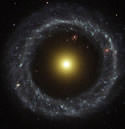
Image credit: Hubble
The latest photo taken by the Hubble Space Telescope is of a rare type of galaxy, known as Hoag’s Object, where a ring of stars orbit a yellow nucleus. The bluish outer ring is composed of clusters of hot, young stars while the heart is made of mostly older stars. It’s possible that the “gap” in between contains star clusters too faint to see.
A nearly perfect ring of hot, blue stars pinwheels about the yellow nucleus of an unusual galaxy known as Hoag’s Object. This image from NASA’s Hubble Space Telescope captures a face-on view of the galaxy’s ring of stars, revealing more detail than any existing photo of this object. The image may help astronomers unravel clues on how such strange objects form.
The entire galaxy is about 120,000 light-years wide, which is slightly larger than our Milky Way Galaxy. The blue ring, which is dominated by clusters of young, massive stars, contrasts sharply with the yellow nucleus of mostly older stars. What appears to be a “gap” separating the two stellar populations may actually contain some star clusters that are almost too faint to see. Curiously, an object that bears an uncanny resemblance to Hoag’s Object can be seen in the gap at the one o’clock position. The object is probably a background ring galaxy.
Ring-shaped galaxies can form in several different ways. One possible scenario is through a collision with another galaxy. Sometimes the second galaxy speeds through the first, leaving a “splash” of star formation. But in Hoag’s Object there is no sign of the second galaxy, which leads to the suspicion that the blue ring of stars may be the shredded remains of a galaxy that passed nearby. Some astronomers estimate that the encounter occurred about 2 to 3 billion years ago.
This unusual galaxy was discovered in 1950 by astronomer Art Hoag. Hoag thought the smoke-ring-like object resembled a planetary nebula, the glowing remains of a Sun-like star. But he quickly discounted that possibility, suggesting that the mysterious object was most likely a galaxy. Observations in the 1970s confirmed this prediction, though many of the details of Hoag’s galaxy remain a mystery.
The galaxy is 600 million light-years away in the constellation Serpens. The Wide Field and Planetary Camera 2 took this image on July 9, 2001.
Original Source: Hubble News Release
Russians Say Bass is Back in Training
Pop singer Lance Bass is getting closer to getting his chance to fly in space according to an announcement from the Russian Space Agency on Friday. Bass, 23, will fly to Houston around the end of August where he will receive training from NASA. Although he is backed by a consortium of companies for the trip, no part of the $20 million fee has been paid yet – the Russians are expecting at least a deposit by the end of this week. If all goes well, Bass will join a Soyuz crew in October to visit the International Space Station for a week. He would become the youngest person ever to fly in space.
Astronauts Install Debris Shields on the Station
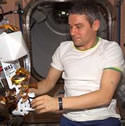
Image credit: NASA
Expedition Five Commander Valery Korzun and Flight Engineer Peggy Whitson spent more than 4 hours in space on Friday, working on improvements to the International Space Station. During this first of two spacewalks scheduled for Expedition Five, the astronauts installed six debris shields to the outside of the Zvezda module – these are designed to stop micrometeorites from damaging the station and crew. Seventeen more shields will be installed in future missions.
Expedition Five Commander Valery Korzun and Flight Engineer Peggy Whitson stepped outside the Pirs Docking Compartment of the International Space Station today and installed debris shields on the Russian Zvezda Service Module in a 4 hour, 25 minute spacewalk.
It was the first of two spacewalks for the Expedition Five crew, the third of Korzun?s career and the first for Whitson. Today?s excursion was the 42nd spacewalk in support of ISS assembly and maintenance and the 17th staged from the station itself. 25 spacewalks at the ISS have originated from visiting space shuttles. While Korzun and Whitson worked outside, Flight Engineer Sergei Treschev tended to station systems and choreographed the spacewalk from inside Zvezda.
After a 1 hour, 43 minute delay to the start of the spacewalk because of a misconfigured valve regulating the operation of the primary oxygen bottles in their Orlan spacesuits, Korzun and Whitson opened the hatch to Pirs at 4:23 a.m. Central time (923 GMT) as the ISS flew over the southern Atlantic Ocean east of the southern coast of South America at an altitude of 230 statute miles. Their first task was to set up tools and unfurl a telescoping crane called the Strela boom from the side of the docking module that is attached to the nadir port of Zvezda.
They pressed ahead to move six micrometeoroid debris shields from a temporary stowage location on the connecting module adapter between the U.S. and Russian segments of the ISS that were delivered in June during the STS-111 mission of the shuttle Endeavour.
One by one, the shields were affixed around Zvezda, designed to provide debris protection for the lifetime of the module. 17 additional shields will be flown to the ISS on future missions to complete the job.
Because of the late start to the spacewalk, Russian flight controllers decided to defer the refurbishment of an experiment on Zvezda called Kromka, designed to collect samples of residue emitted from the module?s jet thrusters. That lower priority task and the swabbing of thruster residue from Zvezda?s hull for analysis will be conducted on a future spacewalk. It was not immediately known whether Korzun and Treschev would perform those tasks next Friday during the second spacewalk of the Expedition.
After retrieving their tools and stowing the Strela crane, Korzun and Whitson returned to Pirs and closed the hatch at 8:48 a.m. Central time (1348 GMT) to wrap up their excursion.
Korzun will venture outside Pirs one week from today with Treschev to install equipment on the exterior of the Russian module which will facilitate the placement of future payloads and the routing of spacewalkers? tethers and to replace Japanese experiments outside Zvezda which measure the effect of atomic oxygen in low Earth orbit on sample materials. Korzun and Treschev will also install two additional amateur radio antennas outside Zvezda to improve contacts with ham radio operators on Earth.
Information on the crew’s activities aboard the space station, future launch dates, as well as station sighting opportunities from anywhere on the Earth, is available on the Internet at:
http://spaceflight.nasa.gov
Details on station science operations can be found on an Internet site administered by the Payload Operations Center at NASA’s Marshall Space Flight Center in Huntsville, Ala., at:
http://www.scipoc.msfc.nasa.gov
The next ISS status report will be issued on Friday, Aug. 23, after the next station spacewalk, or sooner, if events warrant.
Original Source: NASA News Release
